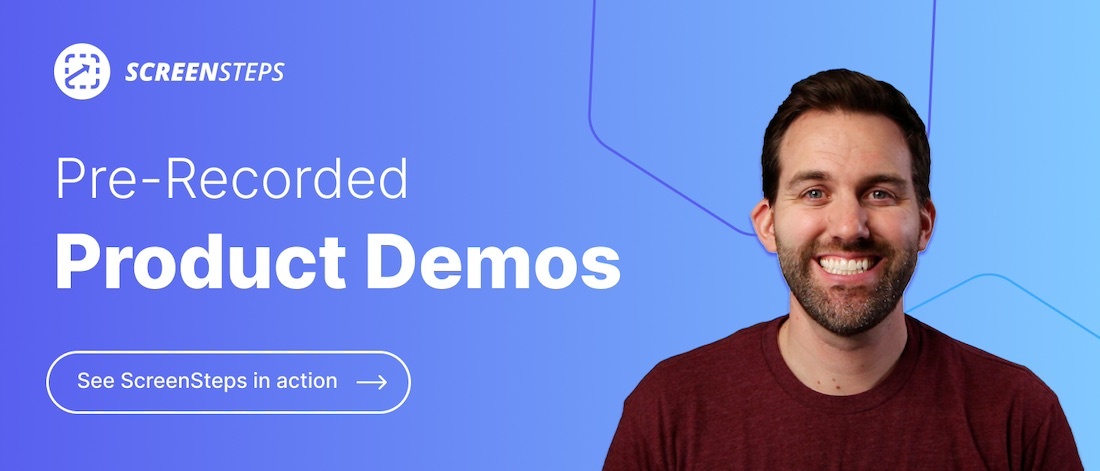How ScreenSteps Prepares You to Manage Change
Nobody likes change. And making changes to your company … well, let’s just say you wish you didn’t have to.
But, you know change is essential for growth in your company. The challenge is that when you make operational changes productivity and performance drop. It’s understandable while you implement new software or processes, but it is frustrating.
Sports teams refer to major line-up changes as “growing years.” And while it is perfectly normal to have growing pains during your change management projects (aka “a growing year”), you’d like to avoid it.
You need a solution so that you can continue operations during your change management project at the pace you are currently performing. There is no need to improve KPIs immediately. If you could do that, your project would be a success. And now you’ve found ScreenSteps.
Many companies have used ScreenSteps for exactly this purpose. As the Director of Transformational Services, I’ve worked with companies as they’ve undergone major operational changes.
They expected to lose productivity and performance during their change management project. Instead, they were able to maintain the status quo when they became a Find & Follow Organization and used a ScreenSteps knowledge base.
In this article, I’ll explain the different types of change management and the tools ScreenSteps uses to help ease the challenges that come with operational change.
Types of changes your company may experience
There are many different types of changes in your business. Some have a larger impact on your company than others. Ultimately, business changes can be broken down into minor and major changes.
Minor changes
A minor change is the inevitable, day-to-day changes that happen in your business. These are frequent changes.
This could be a small change in a policy or a procedure. A small change would be:
- Updating information for accuracy
- Adding a step to a standard operating procedure
- Clarifying a point in a policy or procedure
- Changing a date or cost
These changes don’t require a major overhaul or training to prepare employees and continue operations.
Major changes
Major changes have a larger impact on your business. These types of changes are less frequent.
A major change could involve:
- Swapping out old CRM
- New software rollouts
- Operational changes (i.e. intensive changes to policies and procedures)
With major changes, you often need to slow down your operations or stop them all together in order to train your employees and implement the new processes and/or software.
How change disrupts operations in business
Why does change disrupt your business operations?
Whenever you make major changes to your business processes and software, it requires a paradigm shift. Everyone from the top of your organization down to your new hires need to make behavior changes.
Change has a domino effect. Planning is the first domino to fall. This is done with company and project leaders. Then you need to implement those changes. Ultimately, these changes trickle down through your company. But, that takes more work than falling dominos.
Part of the implementation requires training those employees on the changes. Depending on the extent of those changes, that could mean pulling people off of their job for a few hours to days to train them on those changes.
Often, these situations cause supervisors and leaders to get overwhelmed by questions. Why? Because even tenured employees need a little extra support as they adjust to and learn the changes.
Changes, while necessary, lead to a temporary dip in productivity and employee performance. How long that dip lasts once again depends on the situation. This includes lost time and increased expenses.
However, we aren’t saying change is bad! Change is good. Ultimately, the hope is that those changes will balance out and improve productivity and performance. But, typically that means sacrificing your norm and putting in work.
4 ways ScreenSteps helps with change management
ScreenSteps helps alleviate that temporary dip in productivity and performance.
Here are four ways that ScreenSteps’ software tools help mitigate the negative effects of change.
Full disclosure: ScreenSteps best helps businesses with change management when your company commits to being a Find & Follow Organization. That means you use the Find & Follow Training Framework, have employees use your knowledge base articles for every procedure, and you keep those guides up-to-date.
1. Accessible, easy-to-update, & accurate guides
With a ScreenSteps knowledge base, you have a one-stop-shop for all of your company’s information. Employees know exactly where they can turn to get answers to their questions.
They also know they can rely on those help guides to be accurate. That’s because the authoring tools make it easy to update guides. Minor changes to procedures take minutes to update. That means employees don’t have to wait for those changes to trickle down to them.
As soon as the content author publishes those updates, those updates are available to your employees. In fact, the up-to-date article is the only one they see. That means you have no risk of employees pulling up the old version of a guide as you do with PDFs or saved files on their computers.
People are able to immediately implement the changes.
2. Notifications
When articles are changed, you can alert your employees in using two different tools in ScreenSteps. You can push notifications or announcements.
Notifications and announcements are similar in that they communicate that a change has been made to a procedure. The difference is that notifications require your employees to “acknowledge” that they’ve seen and read the notice.
As you implement new changes to your business, you have a lot of information to pass on to your end-users as the project evolves. This streamlines some of the communication.
3. Collaborating
Part of keeping your guides up-to-date is being able to receive feedback from your end-users. Your employees are using the guides every day. They will be the first to notice if something doesn’t make sense or if something is incorrect.
With ScreenSteps, your employees can add comments or revision notes on articles. This helps iron out all the details that come with change management and produce more complete resources.
These tools also allow you to collaborate with your content authors while writing an article.
4. Certifications
Sometimes change management is like a shiny new toy. People are gung-ho about it at first, but then over time they forget about it and fall back into old habits.
With a new knowledge base, we’ve noticed one reason people stop using your knowledge base articles is that they are inaccurate. The guides don’t get updated, so they are no longer reliable and employees don’t trust them.
For a change management project to be complete and successful, you need a system for ensuring your change management strategy keeps on working.
ScreenSteps uses “Content Certifications” to help you keep your help guides accurate. Certifications remind you to review and update your articles according to the frequency (i.e. weekly, monthly, annually, etc.) or dates your set.
Maintain the status quo during change management projects
Sometimes success looks good and steady, not onward and upward. It is not needing to stop operations to make changes.
When you use ScreenSteps to help you with change management, it helps you maintain the status quo throughout implementation. Using a ScreenSteps knowledge base and becoming a Find & Follow Organization makes your team more agile.
First, you can continue without dropping productivity and performance during change management projects. Then ScreenSteps can continue to help you improve performance and KPIs after your team has settled in with the operational changes.
Want to see if ScreenSteps would work with your change management project?
Schedule a time to talk to our ScreenSteps experts to see if ScreenSteps can help you with your change management project as well as future operations.


.png)

